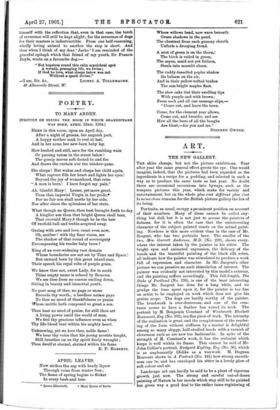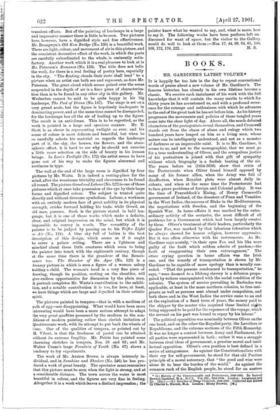ART.
THE NEW GALLERY.
THE skies change, but not the picture exhibitions. Year after year the same general effect greets the eye. One would imagine, indeed, that the pictures had been regarded ELS the ingredients in a recipe for a pudding, and selected in such a way as to produce the same taste as last year. No doubt there are occasional excursions into byways, such as the tempera pictures this year, which make for variety and entertainment, but on the whole plus c'est different plus c'est in mgme chose remains for the British picture gallery the law of its being.
Portraits, as usual, occupy a prominent position on account of their numbers. Many of these cannot be called any- thing but dull, but it is not just to accuse the painters of dulness, for it is often the case that the uninteresting character of the subject painted reacts on the actual paint- ing. Nowhere is this more evident than in the case of Mr. Sargent, who has two portraits here. The smaller of the two, Mrs. Garrett Anderson, M.D. (No. 229), shows every- where the interest taken by the painter in his sitter. The bright eyes and animated expression, the delicacy of the hands and the beautiful painting of the black silk robes, all indicate how the painter was stimulated to produce a work full of expression and character. In Mr. Sargent's other picture we can perceive no such stimulation of interest. The painter was evidently not interested by this model's exterior, and the painting suffers accordingly. This full-length, The Duke of Portland (No. 239), is one of the least interesting things Mr. Sargent has done for a long while, and we grudge the time spent upon it, for the painter is too fine an artist to be employed on work which does not give his, genius scope. The dogs are hardly worthy of the painter. The brushwork is over-dexterous, and one of the crea- tures seems to have a feather boa round its neck. The Portrait by M. Benjamin Constant of Wentworth Blackett Beaumont, Esq. (No. 102), is a fine piece of work. The intensity of the realisation is great, and the completeness of the render- ing of the form without stiffness by a master is delightful among so many sloppy, half-studied heads with a varnish of cleverness such as are now too fashionable. In spite of the strength of M. Constant's work, it has the restraint which keeps it well within its frame. This cannot be said of Mr. John Collier's portrait, Budyard Kipling, Esq. (No. 36), which is as unpleasantly lifelike as a waxwork. M. Dagnan Bouveret shows in A Portrait (No. 241) how strong smooth- ness can be, and has enveloped his sitter in a lovely glow of soft colour and air.
Landscape art can hardly be said to be a plant of vigorous growth just now. The strong and careful out-of-doors painting of Nature in her moods which stay still to be painted hail given way a good deal to the rather tame registering of transient effects. But of the painting of landscape in a large and impressive manner there is little to be seen. Two pictures here, however, have a dignified style and fine effectiveness. Mr. Brangwyn's Old Kew Bridge (No. 138) is a beautiful work. There are light, colour, and movement of air in this picture, and the consistent decorative effect of the work, in which the parts are carefully subordinated to the whole, is eminently satis- factory. Another work which it is a real pleasure to look at is Mr. Paterson's Romance (No. 153). The title does not belie the work, for there is a real feeling of poetry here, especially in the sky. "The floating clouds their state shall lend" to a picture when an artist can both see and represent, as does Mr. Paterson. The great cloud which seems poised over the scene suspended in the depth of air is a finer piece of characterisa- tion than is to be found in any other sky in this gallery. Mr. Wetherbee cannot be said to be quite happy in his big landscape, The Pool of Diana (No. 147). The stage is set on a very grand scale, but the figure is hopelessly inadequate in dominating power, and at the same time cannot be disregarded, for the landscape has all the air of leading up to the figure. The result is an anticlimax. This is to be regretted, as the work is painted in a large and spacious manner. Mr. E. Stott is as clever in representing twilight as ever, and his sense of colour is most delicate and beautiful, but when he so carefully selects his material as regards the landscape part of it, the sky, the houses, the flowers, and the atmo- spheric effect, it is hard to see why he should not exercise a little more selection on the side of beauty in his human beings. In Love's Twilight (No. 172) the artist seems to have gone out of his way to make the figures abnormal and cretinous in type.
The wall at the end of the large room is dignified by four pictures by Mr. Watts. It is indeed a resting-place for the mind, after the wearisome triviality and cleverness to be found all round. The picture Greed and Labour (No. 127) is one of those pictures which at once take possession of the eye by their large forms and dignified colour. The subject is treated quite directly and without tiresome symbolism. Labour, a workman with an entirely modern face of great nobility in its physical strength, strides forward holding his tools, while Greed, an old man, pursues. Such is the picture stated in bald lan- guage, but it is one of those works which make a definite, clear, and original impression on the mind, but which it is impossible to convey in words. The versatility of the painter is to be judged by passing on to his Trifles Light as Air (No. 124). A blue sky full of babies is the best description of this design, which seems as if it ought to cover a palace ceiling. There are a Fghtness and mischief about these little creatures which seem to bring the painter into touch with the eighteenth century, though at the same time there is the grandeur of the Renais- sance too. The Slumber of the Ages (No. 123) is a dreamy picture in which is seen a figure of a woman asleep holding a child. The woman's head is a very fine piece of drawing, though its position, resting on the shoulder, will give endless opportunities for discussion by the plain man. A portrait completes Mr. Watts's contribution to the exhibi- tion, and a notable contribution it is too, for here, at least, we have things which are large and dignified in their artistic spirit.
The pictures painted in tempera—that is, with a medium of yolk of egg—are disappointing. What would have been more interesting would have been a more serious attempt to adapt the very great qualities possessed by the medium to the con- ditions of modern painting rather than slavish imitation of Quattrocento work, with its attempt to put back the wheels of time. One of the qualities of tempera, as pointed out by M. Vibert, is that the freshness of pastel cart be attained without its extreme fragility. Mr. Petrie has painted some 3harming sketches in tempera, Nos. 58 and 62; and Mr. Walter Crane's large Fountain of Youth (No. 67) shows a tendency to try experiments.
The work of Mr. Austen Brown is always intensely in- dividual, and in Sunshine and Shadow (No. 246) he has pro- duced a work of great beauty. The spectator must remember that this picture must be seen when the light is strong, and at a considerable distance. The town across the water is most beautiful in colour, and the figures are very fine in feeling. Altogether it is a work which leaves a distinct impression; the painter knew what he wanted to say, and, what is more, how to say it. The following works have been perforce left un. discussed for want of space, but the visitor to the Gallery would do well to look at them :—Nos. 17, 44, 69, 84, 85, 106,























































 Previous page
Previous page